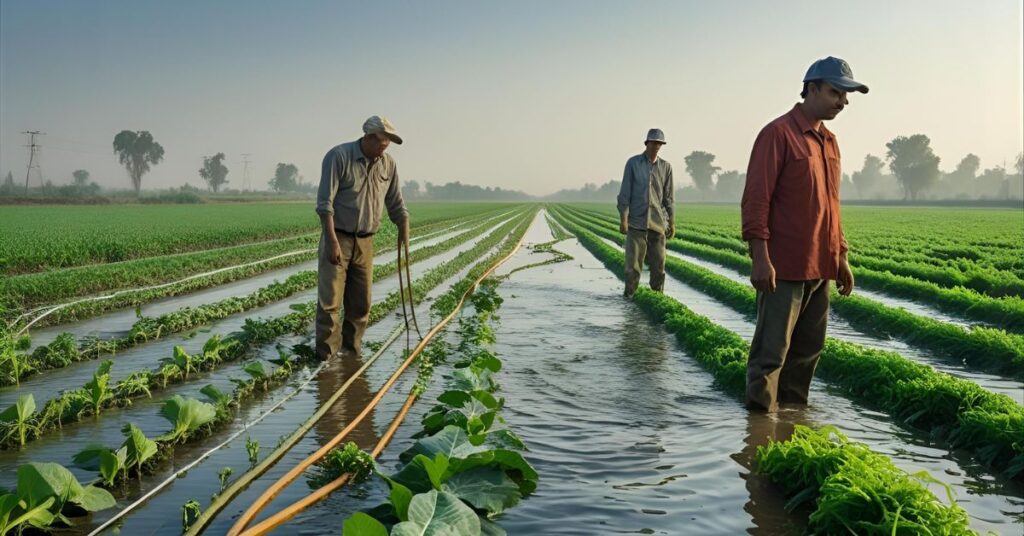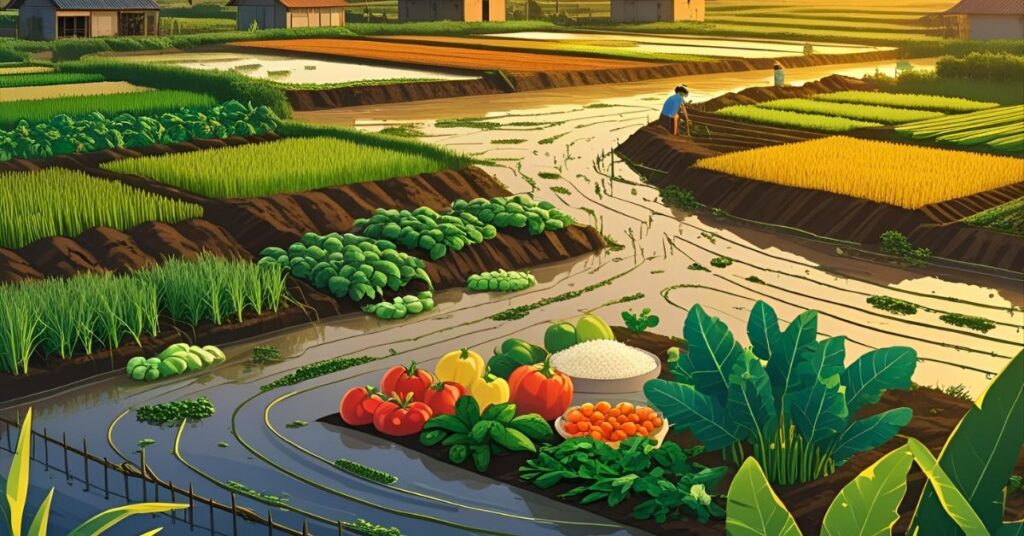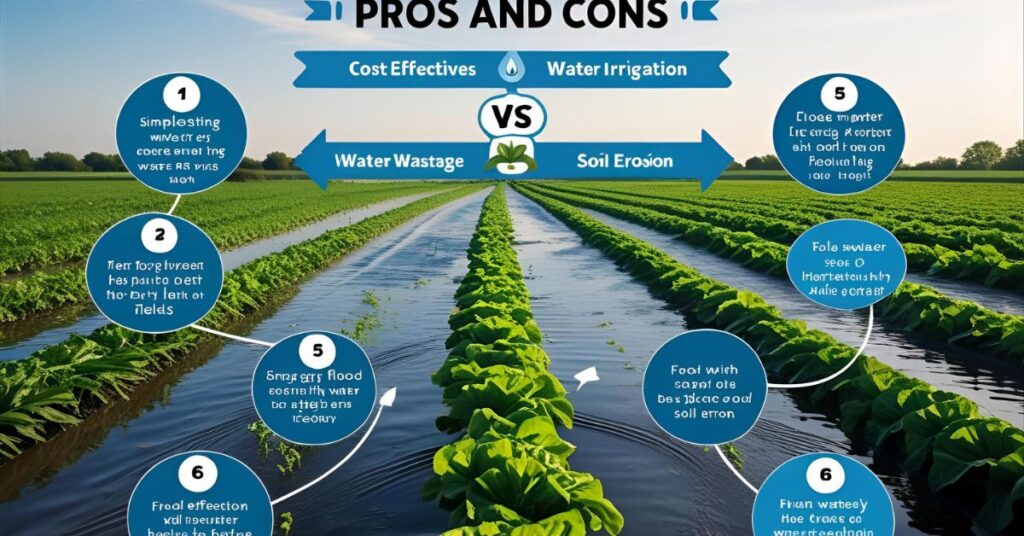Flood irrigation is one of the oldest and most widely used methods of watering crops around the world. Especially common in regions with abundant surface water and flat terrains, this traditional technique involves channelling water directly across fields using gravity. While it’s praised for its simplicity and low setup costs, it also comes with several environmental and efficiency concerns.
In this article, we’ll explore the Top 10 Flood Irrigation Pros and Cons You Should Know to help you determine whether it’s the right fit for your farming needs. From water usage and soil health to energy savings and crop suitability, we’ll break down the key advantages and disadvantages of this age-old irrigation approach — so you may decide with knowledge based on facts, not assumptions.
What Is Flood Irrigation?
Flood irrigation is a traditional method of watering crops by allowing water to flow freely over the surface of a field. This technique relies on gravity rather than mechanical pumps to distribute water, making it one of the simplest and oldest forms of surface irrigation still in use today.
Flood irrigation definition? In flood irrigation, water is diverted from natural sources like rivers, canals, or reservoirs and directed into the fields through open channels or pipes. The water spreads across the soil surface, soaking into the ground and nourishing the crops. While it requires less technical infrastructure, it does depend heavily on field levelling and soil type to ensure even distribution.
There are three main types of flood irrigation, each suited to different landscapes and crop types:
- Basin Irrigation: Water is applied to flat, enclosed plots of land surrounded by levees. It’s commonly used for rice paddies and orchards.
- Border Irrigation: Water flows between raised earth borders that divide the field into strips. This furrow method of irrigation works well for pasture and grain crops.
- Furrow Irrigation: Water runs through shallow furrows or trenches between crop rows. It’s ideal for row crops like corn, cotton, and potatoes.
Each of these techniques has its unique benefits and challenges, which we’ll explore further in the next section on the top pros and cons of flood irrigation.
Flood Irrigation Advantages And Disadvantages

Top 5 Pros of Flood Irrigation
Flood irrigation remains a preferred method for many farmers worldwide — and for good reason. Here are the top 5 pros of flood irrigation you should know:
1. Low Initial Cost
One of the most significant advantages of flood irrigation is its affordability. This furrow irrigation method requires minimal infrastructure — no need for expensive pumps, sprinklers, or drip systems. Farmers often use simple channels or ditches to divert water from nearby sources. As a result, it’s especially ideal for small-scale farms or developing regions where financial resources and access to advanced equipment may be limited.
2. Simple to Operate
Flood irrigation is easy to set up and maintain, making it highly accessible for those with little or no technical training. Farmers can control water distribution manually without relying on complicated machinery. This simplicity makes it well-suited to traditional agricultural practices and regions with limited access to modern technology.
3. Effective for Specific Crops
Some crops thrive under flood irrigation. It’s particularly effective for water-loving crops such as rice, pasture grass, sugarcane, and certain types of forage. These plants benefit from consistent, widespread moisture that this irrigation method can easily provide across flat landscapes.
4. Natural Soil Recharging
Flooding fields can help replenish groundwater levels by permitting too much water to percolate into the ground and percolate down into aquifers. In areas where water tables are falling, periodic flood irrigation can act as a passive method of natural aquifer recharge, contributing to long-term soil and water sustainability.
5. Minimal Energy Use
Unlike pressurised systems that rely on electricity or fuel-powered pumps, flood irrigation relies on gravity to distribute water. This reduces the farm’s energy consumption and operational costs, making it an energy-efficient option for areas where the power supply is unreliable or costly.
Top 5 Cons of Flood Irrigation
While flood irrigation has its benefits, it’s not without drawbacks. Understanding the potential downsides is crucial before deciding if this flood irrigation method suits your land and crops. Here are the top 5 cons of flood irrigation to consider:
1. Water Waste
Flood irrigation is often criticised for its low water-use efficiency. Flood irrigation percent of water lost. A significant amount of water can be lost to evaporation, deep percolation, or runoff, especially in hot or windy climates. Compared to modern irrigation methods like drip or sprinkler systems, flood irrigation consumes more water to achieve the exact crop yield, a significant concern in water-scarce regions.
2. Soil Erosion
When water flows too quickly over fields, it can erode the topsoil, particularly on sloped or uneven land. This loss of nutrient-rich soil can reduce crop productivity and damage long-term soil health. Without proper field levelling and management, erosion becomes a serious risk with flood irrigation.
3. Weed and Pest Growth
Excess moisture left on the field surface creates a favourable environment for weed germination and pest infestations. Stagnant water can also promote fungal diseases and other plant pathogens, which may require increased pesticide or herbicide use, raising both costs and environmental impact.
4. Uneven Water Distribution
Achieving uniform water coverage can be difficult with flood irrigation, especially in larger fields or those with irregular topography. Some areas may receive too much water, while others remain dry. This inconsistency can lead to uneven crop growth, reduced yields, and wasted water.
5. Not Suitable for All Soils
Flood irrigation works best on clay or loamy soils that retain water well. However, on sandy or highly porous soils, water drains too quickly, making the method ineffective. These soil types require more precise irrigation to ensure proper moisture retention, which flood irrigation cannot provide.
If you’ve ever wondered why do bananas split, check out our helpful guide and shop for bananas that are carefully handled to prevent splitting.
Flood Irrigation vs. Modern Methods

As agriculture evolves, so do the techniques used to water crops. While flood irrigation remains widely practised, modern systems like drip irrigation and sprinkler irrigation are increasingly popular due to their efficiency and precision.
Drip Irrigation
Water is delivered straight to plant roots using drip systems through a network of tubing and emitters. This method significantly reduces water waste, improves nutrient absorption, and minimises weed growth. It’s ideal for high-value crops, greenhouses, and areas where water conservation is critical. However, drip irrigation requires a higher upfront investment and ongoing maintenance.
Sprinkler Irrigation
Sprinkler systems simulate rainfall by spraying water over crops through overhead nozzles. They provide more uniform coverage than flood irrigation and are better suited for sloped or uneven fields. Is flood irrigation efficient? Sprinklers are versatile and efficient, but may lose water to evaporation in hot, windy climates and also involve higher operational costs than traditional methods.
When Flood Irrigation Still Makes Sense
Despite its drawbacks, flood irrigation can still be a viable option in certain situations:
- Flat, level fields with water-retentive soil types.
- Crops that require or tolerate standing water, like rice or pasture grasses.
- Regions with abundant surface water and limited access to modern technology or capital.
- Small-scale or traditional farms where simplicity and low cost outweigh water-use concerns.
In short, while modern irrigation systems offer better efficiency and control, flood irrigation remains relevant where conditions align with its strengths, especially when water supply is sufficient and infrastructure investments are limited.
Where is Flood Irrigation Used

Flood irrigation is commonly used in agricultural regions with flat terrain, abundant surface water, and traditional farming systems. It’s border flooding irrigation is especially prevalent in areas where modern irrigation infrastructure is limited or expensive to implement. Here are some of the key regions where flood irrigation is widely practised:
Regions Where Flood Irrigation Is Common:
- India – Used extensively for rice paddies, sugarcane, and wheat in states like Punjab, Haryana, and Uttar Pradesh.
- China, especially in the southern provinces, is known for rice cultivation.
- Egypt – Along the Nile River, where basin and border flood irrigation has been used since ancient times.
- Pakistan – In the Indus River Basin, for crops like cotton, rice, and sugarcane.
- United States – Particularly in the western states (e.g., California, Arizona, Colorado) for alfalfa, pasture, and some grains.
- Mexico – In flat, irrigated zones for corn and beans.
- Southeast Asia – Countries like Vietnam, Thailand, and the Philippines use flood irrigation for rice cultivation.
- Africa – In parts of Sudan, Ethiopia, and Mali, especially near rivers and lowland areas.
Why These Areas?
- Access to river or canal systems
- Flat or gently sloped fields
- Traditional farming practices
- Need for low-cost irrigation methods
Learn why do tomatoes split and how to choose the freshest, best-quality tomatoes from our store.
Conclusion
Flood irrigation is a time-tested method that continues to serve farmers across the globe, particularly in regions where simplicity, low cost, and gravity-fed systems are practical. As we’ve explored in this guide on the Top 10 Flood Irrigation Pros and Cons You Should Know, this technique offers advantages like affordability, ease of use, and suitability for specific crops. Still, it also comes with challenges such as water waste, uneven distribution, and soil erosion.
It’s important to remember that there’s no one-size-fits-all irrigation method. What works well for one field or crop may not be suitable for another. The best choice depends on several factors, including crop type, soil texture, land topography, water availability, and budget.
By carefully considering the advantages and disadvantages and comparing flood irrigation with modern alternatives like drip or sprinkler systems, you can make a well-informed decision that supports both your farm’s productivity and long-term sustainability.
FAQs:
1. What is flood irrigation used for?
Flood irrigation is primarily used to irrigate flat agricultural fields and is especially effective for crops like rice, pasture grasses, and sugarcane that can tolerate or benefit from standing water.
2. Is flood irrigation cost-effective?
Yes, flood irrigation is cost-effective in terms of setup, as it requires minimal infrastructure. However, it may lead to higher long-term water use, which can impact overall efficiency depending on your region and water availability.
3. How does flood irrigation compare to drip irrigation?
Drip irrigation is more water-efficient and targeted, making it ideal for water-scarce areas and high-value crops. In contrast, flood irrigation is simpler and cheaper, but can result in more water waste and uneven coverage.
4. What types of soil work best for flood irrigation?
Flood irrigation works best on clay or loamy soils, which retain water well. It is not suitable for sandy or porous soils, where water drains too quickly and leads to inefficiency.
5. Can flood irrigation cause environmental problems?
Yes, if not correctly managed, flood irrigation can lead to soil erosion, waterlogging, increased weed growth, and groundwater contamination due to fertiliser runoff.





